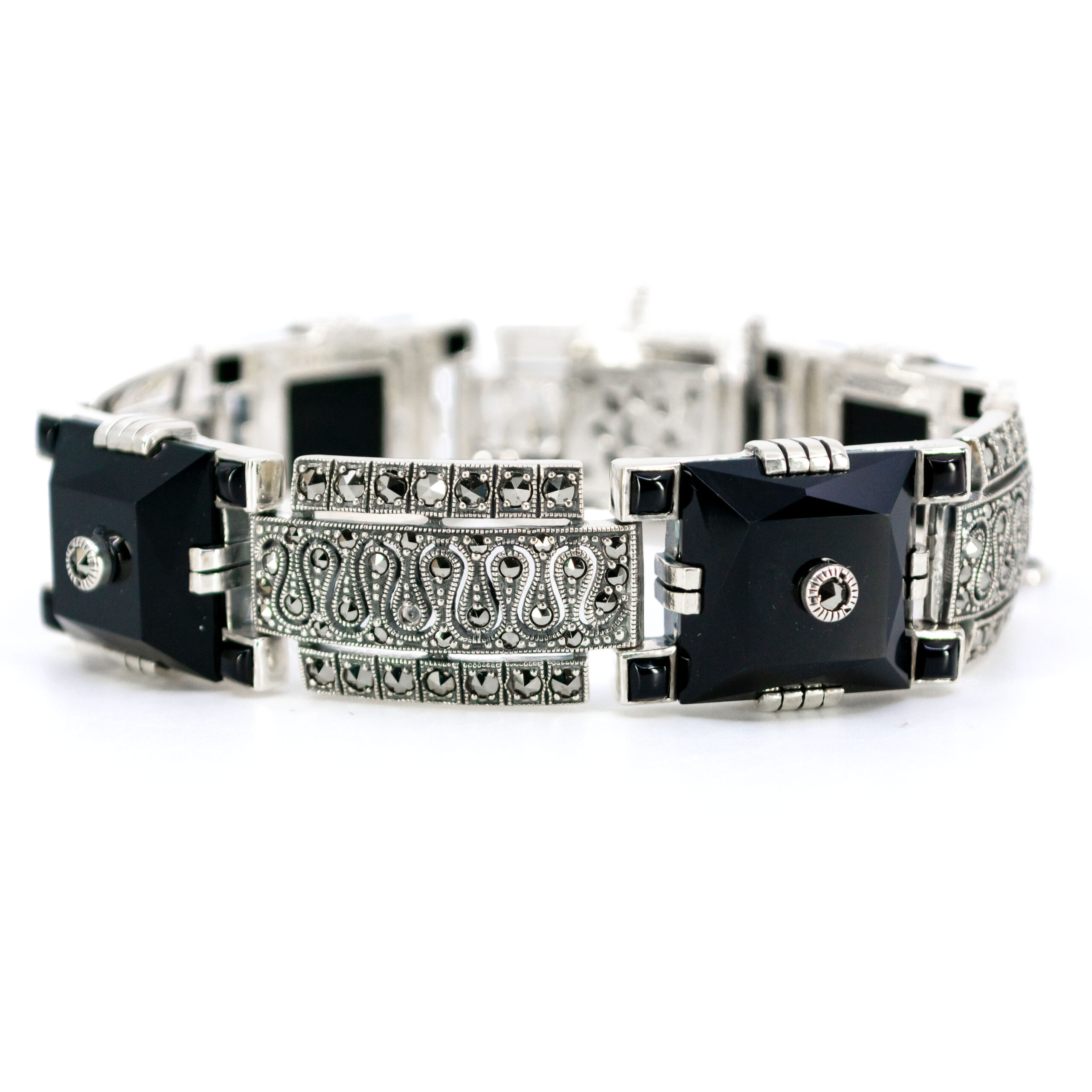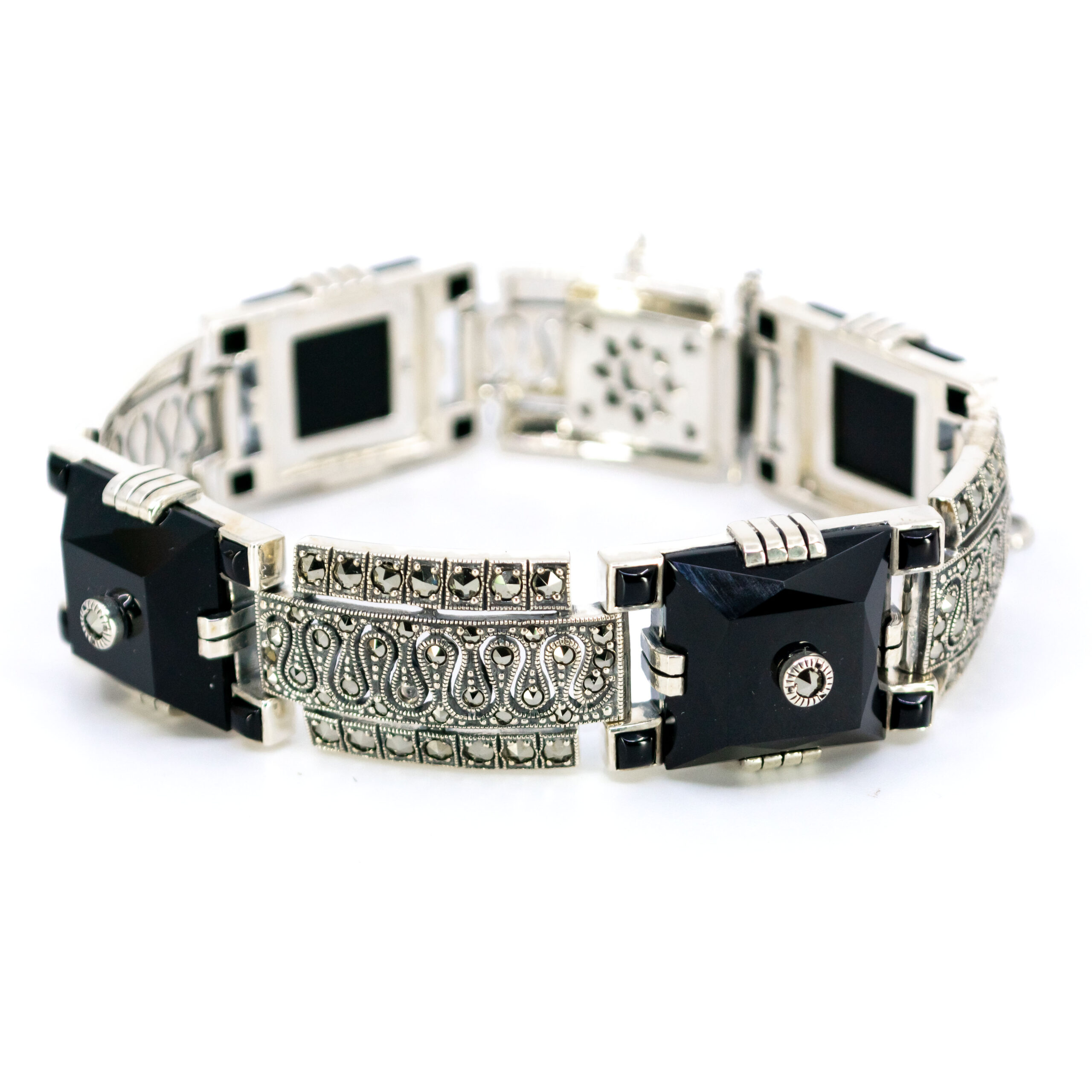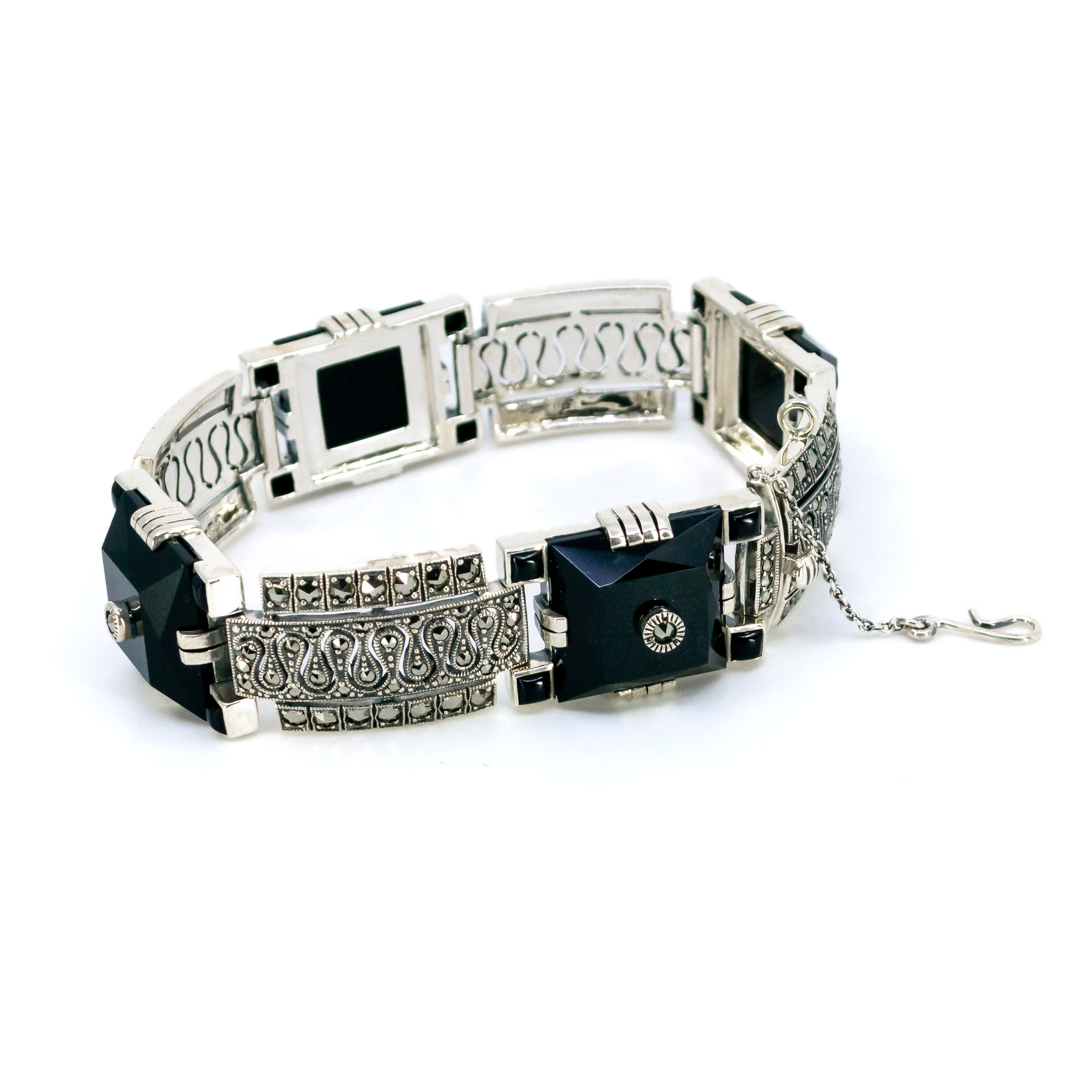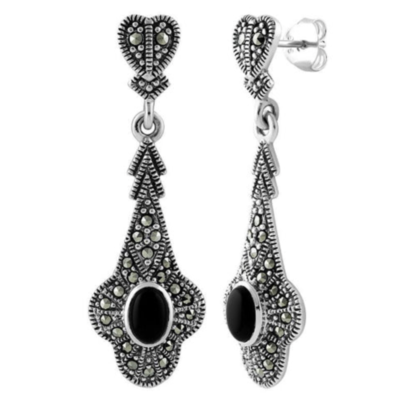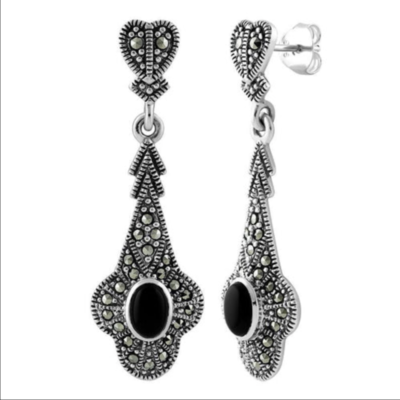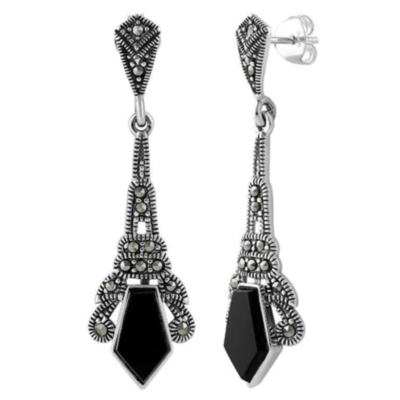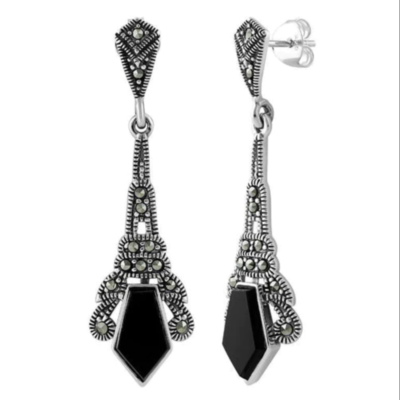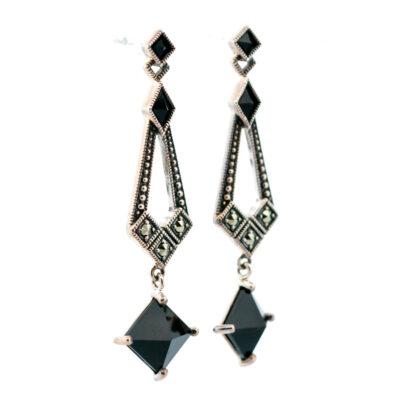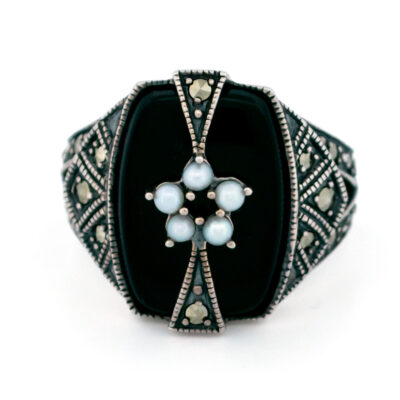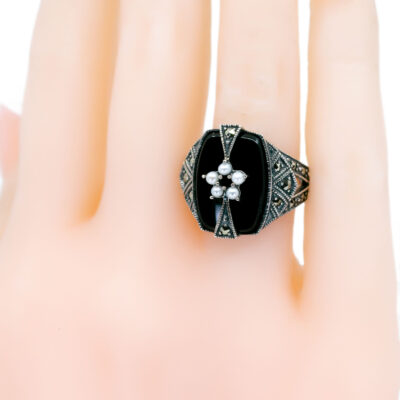This Art Deco-inspired bracelet showcases striking onyx stones paired with shimmering marcasites, meticulously set in silver. The intricate detailing adds vintage charm, making it a captivating accessory for both special occasions and everyday sophistication.
This Art Deco-inspired bracelet showcases striking onyx stones paired with shimmering marcasites, meticulously set in silver. The intricate detailing adds vintage charm, making it a captivating accessory for both special occasions and everyday sophistication.
Details: Onyxes, Marcasites (pyrite), Silver Bracelet
Dimensions: 17.5 x 1.7 cm.
Weight in grams: 47.
Condition: New.
| Design Era | |
|---|---|
| Design & Historical Context |
Art Deco jewelry, also known as Jazz Age jewelry, became popular in the 1920s and remained in style through the 1930s. It was named after the Exposition International des Arts Décoratifs et Industriels Modernes, a exhibition held in Paris in 1925 that was largely dedicated to the jewelry arts. This style was inspired by a variety of cultural and artistic movements, such as Oriental, African, and South American art, as well as Cubism and Fauvism. Art Deco jewelry is known for its sharp, straight lines and emphasis on modernity and the machine age. During the Art Deco era, there were significant improvements in diamond cutting techniques, which made diamonds more radiant and sparkling than ever before. This, along with increased prosperity, allowed more people to afford diamond jewelry and engagement rings. Additionally, new casting techniques made it possible to produce more intricate and detailed settings. Art Deco jewelry was not only fashionable but also reflected the social and cultural changes of the time. The bold, modern design of Art Deco jewelry reflected the liberation and empowerment of women during the 1920s and 1930s. Today, Art Deco jewelry is highly sought after by collectors and is often featured in museum exhibitions and high-end auctions. |
| Key Materials | |
| Materials & Craftsmanship |
Onyx: The Stone of Strength and Protection Onyx, known for its sleek, jet-black appearance, is a gemstone that embodies strength, protection, and grounding energy. It is a form of chalcedony, a variety of quartz, and is often found with parallel bands of black and white, though solid black onyx is the most sought after for its striking simplicity and elegance. Historically, onyx has been revered for its protective qualities. In ancient Rome and Greece, warriors wore onyx amulets to provide courage and strength during battles. In many cultures, it was believed that onyx could absorb negative energy and protect the wearer from harm, making it a popular choice for talismans and protective jewelry. In modern jewelry, onyx is prized for its versatility and bold appearance. Its smooth, polished surface makes it ideal for carving into cameos, intaglios, or sleek cabochons used in rings, bracelets, and necklaces. Onyx pairs beautifully with both silver and gold, creating a dramatic contrast that enhances the sophistication of any design. Onyx is more than just a gemstone; it is a symbol of resilience, inner strength, and timeless style. Its deep, dark beauty and historical significance make it an elegant and powerful choice for jewelry that makes a statement. Marcasite (pyrite): The Gem of Timeless Elegance and Vintage Charm Marcasite, often mistakenly referred to as pyrite, is a gemstone that has captivated jewelry enthusiasts for centuries with its metallic luster and vintage appeal. Although marcasite is technically a form of pyrite, true marcasite jewelry is made from pyrite crystals that are cut and polished to create a shimmering, antique look. Historically, marcasite has been admired for its mysterious, reflective surface, often used in intricate, filigree designs during the Victorian and Art Deco periods. In the 18th and 19th centuries, it became particularly popular in Europe as a more affordable alternative to diamonds, lending an air of elegance and sophistication to brooches, rings, and other accessories. In modern jewelry, marcasite is prized for its ability to add a touch of vintage charm and drama to any piece. Its metallic, gunmetal-gray hue pairs beautifully with silver settings, and its natural sparkle makes it a standout in both understated and ornate designs. Marcasite is commonly seen in rings, earrings, pendants, and brooches, often set in sterling silver to enhance its classic, antique look. Marcasite is more than just a gemstone; it is a symbol of timeless elegance and enduring style. Its historical significance and unique, reflective quality make it a cherished choice for jewelry that exudes both character and sophistication, perfect for those who appreciate the charm of vintage-inspired designs. Silver: The Metal of Elegance and Versatility Silver, known for its bright, reflective luster, is one of the most beloved and widely used precious metals in the world. This versatile metal has been cherished for thousands of years, not only for its beauty but also for its malleability, making it ideal for crafting intricate and delicate jewelry designs. Historically, silver has been associated with the moon and considered a symbol of purity, clarity, and protection. Ancient civilizations, from the Egyptians to the Greeks and Romans, valued silver for its beauty and used it to create coins, jewelry, and religious artifacts. In many cultures, silver is also believed to have healing properties, often used in amulets and talismans to ward off negative energy. In modern jewelry, silver is prized for its affordability, versatility, and timeless appeal. Sterling silver, an alloy of 92.5% pure silver and 7.5% other metals (usually copper), is the standard used in high-quality jewelry. Its durability and bright, reflective surface make it an excellent choice for a wide range of designs, from minimalist pieces to ornate creations. Silver can be polished to a high shine or given a matte, oxidized, or antiqued finish to suit various styles. Silver is more than just a metal; it is a symbol of elegance, flexibility, and understated luxury. Its enduring popularity and wide-ranging applications make it a staple in jewelry that can complement any look, from casual to formal, with timeless grace. : The Metal of Elegance and Versatility Silver, known for its bright, reflective luster, is one of the most beloved and widely used precious metals in the world. This versatile metal has been cherished for thousands of years, not only for its beauty but also for its malleability, making it ideal for crafting intricate and delicate jewelry designs. Historically, silver has been associated with the moon and considered a symbol of purity, clarity, and protection. Ancient civilizations, from the Egyptians to the Greeks and Romans, valued silver for its beauty and used it to create coins, jewelry, and religious artifacts. In many cultures, silver is also believed to have healing properties, often used in amulets and talismans to ward off negative energy. In modern jewelry, silver is prized for its affordability, versatility, and timeless appeal. Sterling silver, an alloy of 92.5% pure silver and 7.5% other metals (usually copper), is the standard used in high-quality jewelry. Its durability and bright, reflective surface make it an excellent choice for a wide range of designs, from minimalist pieces to ornate creations. Silver can be polished to a high shine or given a matte, oxidized, or antiqued finish to suit various styles. Silver is more than just a metal; it is a symbol of elegance, flexibility, and understated luxury. Its enduring popularity and wide-ranging applications make it a staple in jewelry that can complement any look, from casual to formal, with timeless grace. |
| Dimensions |
17.5 x 1.7 cm |
| Weight (in grams) |
47 |
| Condition |
By following these tips, you can enjoy your precious jewelry for many years to come.
Related Products
-
Marcasite (Pyrite) Onyx Silver Pendant Earrings 14780-1858
€ 135,00 VAT incl. (where applicable) -
Marcasite (Pyrite) Onyx Silver Ring 14773-1851
€ 135,00 VAT incl. (where applicable) -
Marcasite (Pyrite) Onyx Silver Drop Earrings 14769-1847
€ 285,00 VAT incl. (where applicable) -
Marcasite (Pyrite) Onyx Silver Pendant Earrings 14770-1848
€ 195,00 VAT incl. (where applicable) -
Marcasite (Pyrite) Onyx Silver Drop Earrings 14771-1849
€ 285,00 VAT incl. (where applicable) -
Onyx Marcasite (Pyrite) Silver Drop Earrings 14685-1769
€ 195,00 VAT incl. (where applicable) -
Onyx Marcasite (Pyrite) Silver Pendant 14748-1828
€ 185,00 VAT incl. (where applicable) -
Onyx Pearl Marcasite (Pyrite) Silver Ring 14728-1810
€ 245,00 VAT incl. (where applicable)
- Home
-
Collection
- Fine Jewelry
- Silver Jewelry
-
Silverware
- Boxes
- Candlesticks
- Salt and pepper shakers
- Miniatures
- Salt cellars
- Spoon Set
- Condiments
- Frames
- Napkin Ring
- Spoon
- Oddities
- Cups
- Vases
- Cutlery
- Serving Spoon And Cake Server
- Candlesticks
- Baskets
- Hanukkiah
- Spice Tower
- Yad
- Tea Set
- Sugar Castor
- Napkin Rings
- Wine Bottle Coaster
- Wine Stopper
- Tea Pot
- Jugs
- Rattles
- Hip Flask
- Miscellaneous
- Rings 💍
- About
- Contact
